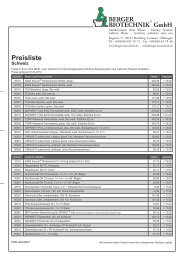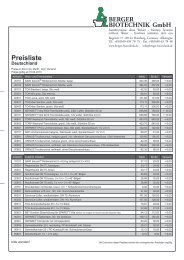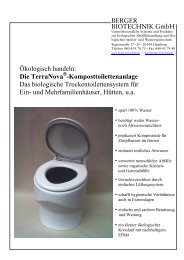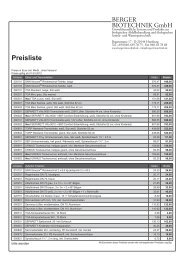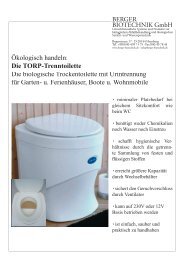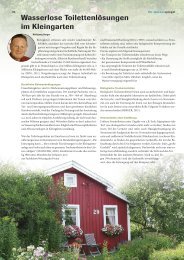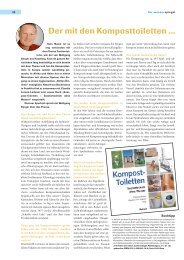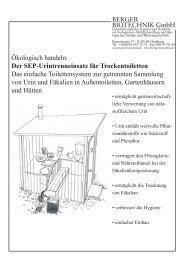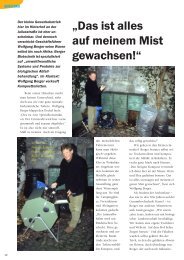Nachhaltiger Wohnen in der Solarsiedlung ... - ANU Hamburg
Nachhaltiger Wohnen in der Solarsiedlung ... - ANU Hamburg
Nachhaltiger Wohnen in der Solarsiedlung ... - ANU Hamburg
Sie wollen auch ein ePaper? Erhöhen Sie die Reichweite Ihrer Titel.
YUMPU macht aus Druck-PDFs automatisch weboptimierte ePaper, die Google liebt.
<strong>Nachhaltiger</strong> <strong>Wohnen</strong> | InhaltE<strong>in</strong>leitung ..........................................................2Die Ökologische Siedlung Braamwisch unddie <strong>Solarsiedlung</strong> Karlshöhe <strong>in</strong> <strong>Hamburg</strong>............3Wärme von <strong>der</strong> Sonne – e<strong>in</strong>ehrgeiziges Pilotprojekt setzt Zeichen................4Solare Nahwärmeversorgung – e<strong>in</strong>eBilanz nach zehn Jahren Betriebszeit.................. 5Mit guter Dämmung und ökologischenBaustoffen zum Niedrigenergiehaus................... 7E<strong>in</strong>e kontrollierte Lüftung undLehmwände sorgen für gutes Klima ...................9Übersichtsplan................................................. 10Solarstrom produzieren und Strom sparen....... 12Abwasserre<strong>in</strong>igung im Schilfbeet...................... 13Mit Komposttoiletten denNährstoffkreislauf schließen............................. 14Regenwasser s<strong>in</strong>nvoll nutzen............................ 16Spielflächen für K<strong>in</strong><strong>der</strong> stattParkplätze für Autos......................................... 16Kosten und Nutzen ökologischen Bauens......... 18Klimaschutz seit zehn Jahren............................ 19Aus Erfahrungen lernenund gute Ideen weitergeben.............................20Literatur, L<strong>in</strong>ks, Fotonachweis.......................... 21Kontakte...........................................................22ContentsIntroduction .......................................................2The Braamwisch Ecological Settlement andthe Karlshöhe Solar Settlement <strong>in</strong> <strong>Hamburg</strong>.......3Heat from the sun – anambitious pilot project sets new standards........4Solar municipal heat<strong>in</strong>g – draw<strong>in</strong>gthe balance after ten years of operation............. 5Effective <strong>in</strong>sulation and ecological constructionmaterials give rise to the low-energy house........ 7Controlled ventilation and cobwalls provide good climatic conditions...............9Site plan........................................................... 10Produc<strong>in</strong>g solar current and sav<strong>in</strong>g energy....... 12Purify<strong>in</strong>g waste water by means of reedbeds.... 13Clos<strong>in</strong>g the cycle of nutrientswith compost<strong>in</strong>g toilets.................................... 14Intelligent use of ra<strong>in</strong>water............................... 16Play areas for children<strong>in</strong>stead of car parks.......................................... 16Costs and benefits of ecological build<strong>in</strong>g......... 18Ten years of climate protection......................... 19Learn<strong>in</strong>g from experienceand pass<strong>in</strong>g on good ideas...............................20Literature, l<strong>in</strong>ks, credits.................................... 21Contacts...........................................................22Susta<strong>in</strong>ability: Liv<strong>in</strong>g today <strong>in</strong> a way, that everyone canenjoy live the day after tomorrow, too. Everywhere. [Future Council <strong>Hamburg</strong>]
| <strong>Nachhaltiger</strong> <strong>Wohnen</strong>Introduction<strong>Hamburg</strong> is a metropolis of millions,where every year several thousandnew dwell<strong>in</strong>gs are created. The wishof young families above all to have ahouse of their own <strong>in</strong> a green sett<strong>in</strong>g,while not liv<strong>in</strong>g too far away fromthe city, cont<strong>in</strong>ues unabated. This isgenerally associated with the massiveuse of land area and natural resources,a high turnover of energy and materialsand high levels of emissions.But it does not have to be this way. Tenyears ago, <strong>in</strong> the Bramfeld district <strong>in</strong>north-eastern <strong>Hamburg</strong>, the BraamwischEcological Settlement was created,to demonstrate an alternative. Thesettlement forms part of the KarlshöheSolar Settlement – a comb<strong>in</strong>ation oftwo residential projects <strong>in</strong>volv<strong>in</strong>g a totalof 124 terraced houses, and probablythe only one of its k<strong>in</strong>d <strong>in</strong> Germany.After the appearance of the IPCC reporton climate change and its consequences,a general discussion was launchedon all sides about ways of improv<strong>in</strong>gefficiency and reduc<strong>in</strong>g carbon dioxideemissions. The example presentedhere shows how these targets can bereached <strong>in</strong> residential development.The present brochure, which hasbeen created un<strong>der</strong> the auspicesof the INTERREG IIIB North SeaRegion project LifeSTYLE, is designedto present <strong>in</strong>terested specialistsand consumers with a successfulexample of futuristic residentialdevelopment and liv<strong>in</strong>g conditions <strong>in</strong>the Braamwisch Ecological Settlement.Rat<strong>in</strong>gsOn the follow<strong>in</strong>g pages rat<strong>in</strong>gs areawarded for each ecological element (e.g.solar urban district heat<strong>in</strong>g, compost<strong>in</strong>gtoilets). These are based on measuredvalues, <strong>in</strong>terviews and personalexperience, lead<strong>in</strong>g to an estimate <strong>in</strong>relation to acceptance levels (C), longtermcost sav<strong>in</strong>gs (E) and significancefor climate protection (Y). The scaleranges from high to medium to slight.E<strong>in</strong>leitung<strong>Hamburg</strong> ist e<strong>in</strong>e Millionenmetropole,<strong>in</strong> <strong>der</strong> jedes Jahr mehrere 1 000neue Wohnungen entstehen. DerWunsch vor allem junger Familien,<strong>in</strong> e<strong>in</strong>em eigenen Haus im Grünen,aber doch stadtnah zu wohnen, istungebremst. Damit verbunden istmeistens e<strong>in</strong> massiver Flächen- undNaturverbrauch, e<strong>in</strong> hoher Energie-und Materialumsatz sowiee<strong>in</strong>e Vielzahl von Emissionen.Dies muss nicht so se<strong>in</strong>. Vor zehnJahren entstand im Nordosten<strong>Hamburg</strong>s im Stadtteil Bramfelddie Ökologische Siedlung Braamwisch,die zeigt, dass es auch an<strong>der</strong>sgeht. Die Siedlung ist Teil <strong>der</strong><strong>Solarsiedlung</strong> Karlshöhe – zwei <strong>in</strong>ihrer Komb<strong>in</strong>ation deutschlandweitwohl e<strong>in</strong>malige Siedlungsprojektemit <strong>in</strong>sgesamt 124 Reihenhäusern.Nach Ersche<strong>in</strong>en des IPCC-Berichteszum Klimawandel und se<strong>in</strong>en Folgenist allerorten e<strong>in</strong>e Diskussionum Effizienz-Steigerung und CO2-Verm<strong>in</strong><strong>der</strong>ung <strong>in</strong> Gang gekommen.Das vorgestellte Beispiel zeigtauf, wie diese Ziele im Wohnungsbauerreicht werden können.Die vorliegende Broschüre, die imRahmen des INTERREG IIIB NordseeProjekts LifeSTYLE erstellt wurde,möchte <strong>in</strong>teressierten Fachleutenund Verbrauchern mit <strong>der</strong> ÖkologischenSiedlung Braamwisch e<strong>in</strong>gelungenes Beispiel zukunftsfähigenBauens und <strong>Wohnen</strong>s vorstellen.BewertungAuf den folgenden Seiten wirdzu jedem ökologischen Bauste<strong>in</strong>(z. B. solare Nahwärme, Komposttoilette)jeweils e<strong>in</strong>e Bewertungvorgenommen. Als Grundlagedienen Messwerte, Befragungenund persönliche Erfahrungen, diezu e<strong>in</strong>er E<strong>in</strong>schätzung überu Akzeptanz (C),u langfristige Kostene<strong>in</strong>sparungen(E) undu Bedeutung fürden Klimaschutz (Y)führen. Die Bewertungsskala reichtvon CCC = hoch über EE = mittelbis Y = ger<strong>in</strong>g. Beispiel:CCC E YYY
<strong>Nachhaltiger</strong> <strong>Wohnen</strong> | Die Ökologische Siedlung Braamwisch unddie <strong>Solarsiedlung</strong> Karlshöhe <strong>in</strong> <strong>Hamburg</strong>1996 wurde die <strong>Solarsiedlung</strong>Karlshöhe (Bild unten) als Pilotprojektdes damaligen <strong>Hamburg</strong>erEnergieversorgers <strong>Hamburg</strong>er Gaswerkemit Unterstützung <strong>der</strong> Freienund Hansestadt <strong>Hamburg</strong> sowiedes Bundes gebaut. Sie war e<strong>in</strong>es<strong>der</strong> beiden ersten Großprojekte <strong>in</strong>Deutschland zur »solaren Nahwärmeversorgungmit Langzeitwärmespeicher«<strong>in</strong> e<strong>in</strong>em Neubaugebiet.40 Reihenhäuser <strong>in</strong> dieser Siedlunggehören zur ÖkologischenSiedlung Braamwisch (s. Übersichtsplanauf den Seiten 10 und11). Sie ist das Produkt engagierterBürger<strong>in</strong>nen und Bürger, die ihreVision vom ökologischen Bauenund <strong>Wohnen</strong> <strong>in</strong> die Tat umsetzten.Es entstanden Niedrigenergiehäuseraus ökologischen Baustoffen,ausgestattet mit Komposttoilettenund angeschlossen an e<strong>in</strong>eeigene Pflanzenkläranlage.Bei <strong>der</strong> Planung <strong>der</strong> ÖkologischenSiedlung Braamwisch waren denBauleuten neben dem ThemaKlimaschutz und CO2-E<strong>in</strong>sparungauch an<strong>der</strong>e Aspekte desnachhaltigen Bauens wichtig.u Effizienz (= Erhöhung des Wirkungsgrades)z. B. durch guteDämmung <strong>der</strong> Häuser und damitSenkung des Energieverbrauchsu Konsistenz (= Orientierung anNaturkreisläufen) z. B. durche<strong>in</strong> alternatives Abwasserkonzeptmit Komposttoiletten undPflanzenkläranlage vor Ortu Substitution (= Austausch schädlichergegen umweltfreundlicheund gesundheitlich unbedenklicheStoffe) z. B. durch VerwendungRessourcen sparen<strong>der</strong> und nachwachsen<strong>der</strong>Rohstoffe sowie denE<strong>in</strong>satz regenerativer Energienu Suffizienz (= H<strong>in</strong>länglichkeit) z. B.durch geme<strong>in</strong>same Nutzung vonFreiflächen und durch Carshar<strong>in</strong>gThe Braamwisch EcologicalSettlement and the KarlshöheSolar Settlement <strong>in</strong> <strong>Hamburg</strong>In 1996 the Karlshöhe Solar Settlement(see picture below) was created as apilot project by <strong>Hamburg</strong> Gas Works, thecompany responsible for the city‘s powersupply at that time, with support fromthe Free and Hanseatic City of <strong>Hamburg</strong>and the fe<strong>der</strong>al government. It was oneof the two first major projects <strong>in</strong> Germany<strong>in</strong>volv<strong>in</strong>g solar municipal heat<strong>in</strong>g withlong-term heat storage <strong>in</strong> a new residentialarea.40 terraced houses <strong>in</strong> this settlementbelong to the Braamwisch EcologicalSettlement (for a layout plan, seepages 10 and 11). It is the product ofcommitted citizens who have realised<strong>in</strong> practice, through this project, theirvision of ecological build<strong>in</strong>g and liv<strong>in</strong>g.Low-energy houses were built, us<strong>in</strong>gecological build<strong>in</strong>g materials, equippedwith compost<strong>in</strong>g toilets and connected totheir own plant-based sewage treatmentsystem.In the plann<strong>in</strong>g of the BraamwischEcological Settlement, climate protectionand the reduction of carbon dioxideemissions were not the only consi<strong>der</strong>ations.The developers also had other aspects ofsusta<strong>in</strong>able construction <strong>in</strong> m<strong>in</strong>d.u Efficiency (= rais<strong>in</strong>g the degree ofeffectiveness), e.g. by provid<strong>in</strong>ghouses with good <strong>in</strong>sulation andso reduc<strong>in</strong>g power consumptionu Consistency (= connect<strong>in</strong>g withnatural cycles), e.g. through analternative waste water solution<strong>in</strong>volv<strong>in</strong>g compost<strong>in</strong>g toiletsand an on-site plant-basedsewage treatment systemu Substitution (= replacement of toxicsubstances with environmentallyfriendly substances present<strong>in</strong>g nohazards to health), e.g. throughthe use of resource-sav<strong>in</strong>g andregenerative raw materialsand sources of energyu Sufficiency (= adequacy), e.g.through the shared use of openspaces and car shar<strong>in</strong>g.Foto: 124 Reihenhäuser gehörenzur <strong>Solarsiedlung</strong> Karlshöhe
| <strong>Nachhaltiger</strong> <strong>Wohnen</strong>Heat from the sun – anambitious pilot project setsnew standardsTo supply an entire residential areawith solar heat<strong>in</strong>g – <strong>in</strong> 1996 this wassometh<strong>in</strong>g that had never been done<strong>in</strong> Germany before. The <strong>Hamburg</strong>pilot system was designed to give theidea a first trial. A total of 124 s<strong>in</strong>glefamilyterraced houses have beenconnected to solar collection surfacesmeasur<strong>in</strong>g 3000 square metres <strong>in</strong> all.The water that is heated up <strong>in</strong> the solarcollectors is fed <strong>in</strong>to a subterraneanhot water tank measur<strong>in</strong>g 4500 cubicmetres (see photo below), and shouldcover about 50 percent of what isneeded <strong>in</strong> the way of heat<strong>in</strong>g anddomestic hot water. Two low-temperaturegas-fuelled condens<strong>in</strong>g boilers at thesettlement‘s central heat<strong>in</strong>g unit supplythe miss<strong>in</strong>g heat energy <strong>in</strong> w<strong>in</strong>ter.A large-scale system like this offersvarious advantages <strong>in</strong> comparison with<strong>in</strong>dividual solar collection systems.The houses have neither boilers norchimneys, only a heat transfer stationat which the district heat<strong>in</strong>g supplyarrives, at a temperature of 60°C. It isthen transferred to the house‘s <strong>in</strong>ternalheat<strong>in</strong>g circulation or to domestic hotwater for bath and kitchen, with theamount of heat that has been tappedbe<strong>in</strong>g registered. The residents providethe south-po<strong>in</strong>t<strong>in</strong>g surfaces of theirroofs to be used for the <strong>in</strong>stallationof solar collectors, and pay a one-offconnection charge of 6000 euros. Thisis notably cheaper than the constructionof an <strong>in</strong>dividual solar collectionsystem, which comes at the moment toaround 9000 euros m<strong>in</strong>us subsidies.The operator of the solar urbandistrict heat<strong>in</strong>g system is responsiblefor servic<strong>in</strong>g it. Braamwisch’sresidents pay the standard <strong>Hamburg</strong>remote heat<strong>in</strong>g price for this.Wärme von <strong>der</strong> Sonne – e<strong>in</strong>ehrgeiziges Pilotprojekt setzt ZeichenE<strong>in</strong> ganzes Quartier mit Solarwärmeversorgen – das gab es bis 1996noch nicht <strong>in</strong> Deutschland. In <strong>der</strong><strong>Hamburg</strong>er Pilotanlage sollte dieserstmals erprobt werden. Angeschlossens<strong>in</strong>d <strong>in</strong>sgesamt 124 E<strong>in</strong>familien-Reihenhäusermit <strong>in</strong>sgesamt3 000 m 2 Solarkollektorfläche.Foto: Montage <strong>der</strong> SolarkollektorenDas <strong>in</strong> den Solarkollektoren erwärmteWasser wird <strong>in</strong> e<strong>in</strong>en unterirdischen,4 500 m 3 großen Heißwasserspeichere<strong>in</strong>gespeist (Foto unten) und sollterund 50 Prozent des Wärmebedarfsfür Heizung und Brauchwasserdecken. Zwei Nie<strong>der</strong>temperatur-Gasbrennwertkessel <strong>in</strong> <strong>der</strong> Heizzentrale<strong>der</strong> Siedlung liefern diefehlende Wärmeenergie im W<strong>in</strong>ter:Quelle: www.hamburger-bildungsserver.deE<strong>in</strong>e solche Großanlage bietetim Vergleich zu E<strong>in</strong>zelsolaranlagenmehrere Vorteile.Foto: Bau des Wärmespeichers
<strong>Nachhaltiger</strong> <strong>Wohnen</strong> | In den Häusern gibt es ke<strong>in</strong>e Heizkesselo<strong>der</strong> Schornste<strong>in</strong>e, son<strong>der</strong>nnur e<strong>in</strong>e Wärmeübergabestation, an<strong>der</strong> die Nahwärme mit 60°C ankommtund auf den haus<strong>in</strong>ternen Heizkreislaufbzw. auf das Brauchwasserfür Bad und Küche übertragen unddie abgenommene Wärmemengegemessen wird. Die Bewohner stellendie nach Süden ausgerichtetenFlächen ihrer Hausdächer für dieInstallation <strong>der</strong> Solarkollektorenzur Verfügung und zahlen e<strong>in</strong>maligeAnschlusskosten von 6 000 €.Dies ist deutlich günstiger als <strong>der</strong>E<strong>in</strong>bau e<strong>in</strong>er E<strong>in</strong>zelsolaranlage (ca.9 000 € abzüglich För<strong>der</strong>ung).Die Gesamtkosten für das <strong>Hamburg</strong>erPilotprojekt beliefen sich aufca. 3,4 Mio. € und wurden f<strong>in</strong>anziertdurch das Bundesm<strong>in</strong>isteriumfür Wissenschaft, Forschung undTechnologie (1,5 Mio. €), die Stadt<strong>Hamburg</strong> (0,5 Mio. €), die <strong>Hamburg</strong>erGaswerke als Betreiber (0,7 Mio. €)und die Bauträger mit ca. 6 000 €pro Wohne<strong>in</strong>heit (0,7 Mio. €).Def<strong>in</strong>itionSolarthermie = Nutzung <strong>der</strong>Wärmeenergie <strong>der</strong> Sonnenstrahlungzur Wassererwärmung mitHilfe von SolarkollektorenThe overall costs of the <strong>Hamburg</strong> pilotproject came to aptrox. 3.4 millioneuros. F<strong>in</strong>ance was provided by theFe<strong>der</strong>al M<strong>in</strong>istry of Science, Researchand Technology (1.5 million euros), theCity of <strong>Hamburg</strong> (0.5 million euros),<strong>Hamburg</strong> Gas Works as the operat<strong>in</strong>gcompany (0.7 million euros) and theproject developers with around 6000euros per dwell<strong>in</strong>g unit (0.7 million euros).Def<strong>in</strong>itionsSolar thermal eng<strong>in</strong>eer<strong>in</strong>g = use of theheat energy of solar radiation for heat<strong>in</strong>gup water with the help of solar collectorsPhotovoltaics = direct transformationof sunlight <strong>in</strong>to electrical energywith the help of solar modules.Für die Wartung des solaren Nahwärmesystemsist <strong>der</strong> Betreiber zuständig,die Kunden zahlen dafür denüblichen <strong>Hamburg</strong>er Fernwärmepreis.Fotovoltaik (o<strong>der</strong> Photovoltaik,PV) = direkte Umwandlung desSonnenlichts <strong>in</strong> elektrische Energiemit Hilfe von SolarmodulenSolare Nahwärmeversorgung – e<strong>in</strong>eBilanz nach zehn Jahren BetriebszeitWissenschaftlich begleitet wurdedas Solare Nahwärmeprojektzunächst durch die UniversitätStuttgart und später durch die TechnischeUniversität Braunschweig.Die Betriebsergebnisse zeigen,dass <strong>der</strong> solare Deckungsanteil<strong>in</strong> sonnenreichen Jahren nichtwie geplant 50 Prozent son<strong>der</strong>nmaximal 30 Prozent beträgt.Die Gründe dafür s<strong>in</strong>d zum e<strong>in</strong>enWärmeverluste im Speicher und imNahwärmenetz und zum an<strong>der</strong>enerheblich höhere Netzrücklauftemperaturenals geplant (50°C statt 30°C)sowie <strong>der</strong> höhere Wärmebedarf <strong>der</strong>Häuser (ca. 20 Prozent). Zu berücksichtigenist auch, dass die e<strong>in</strong>zelnenBauabschnitte <strong>der</strong> <strong>Solarsiedlung</strong> mitunterschiedlichen Wärmedämmstandardserrichtet wurden. Nur e<strong>in</strong> Drittel<strong>der</strong> 124 angeschlossenen Häuser s<strong>in</strong>dSolar municipal heat<strong>in</strong>g –draw<strong>in</strong>g the balance afterten years of operationThe solar municipal heat<strong>in</strong>g projectwas given scientific support by theUniversity of Stuttgart <strong>in</strong> the first<strong>in</strong>stance, and later by the TechnicalUniversity of Braunschweig.The operat<strong>in</strong>g results have shownthat the coverage of requirementsprovided by solar energy <strong>in</strong> years withplenty of sunsh<strong>in</strong>e does not come to50 percent, as was orig<strong>in</strong>ally planned,but only to 30 percent at most.The reasons for this are to be foundfirst <strong>in</strong> a heat loss <strong>in</strong> the reservoir andon the heat<strong>in</strong>g network, and then<strong>in</strong> the consi<strong>der</strong>ably higher backflowtemperatures than had been plannedfor (50°C <strong>in</strong>stead of 30°C); the heat<strong>in</strong>grequirements of the houses were alsoabout 20 percent higher than expected.It must be taken <strong>in</strong>to account as wellthat the <strong>in</strong>dividual project phases ofthe solar settlement were carried outon the basis of different heat <strong>in</strong>sulationstandards. Only a third of the 124houses connected to the grid are low-
| <strong>Nachhaltiger</strong> <strong>Wohnen</strong>energy houses, with correspond<strong>in</strong>glylow heat<strong>in</strong>g requirements (less than70 kWh per square metre per year).The present operat<strong>in</strong>g company – eonHanseatic Heat<strong>in</strong>g as the successorof <strong>Hamburg</strong> Gas Works – has takenextensive measures to optimise thefacility <strong>in</strong> the area of control technique.It would still be possible to achievefurther improvements by reduc<strong>in</strong>g thebackflow temperature. This would haveto take place <strong>in</strong> the heat transfer stationsand heat<strong>in</strong>g systems of the houses,and would <strong>in</strong>volve consi<strong>der</strong>able costsfor the residents. But as the residentsof <strong>Hamburg</strong>‘s solar settlement do notbenefit from their solar heat<strong>in</strong>g supply<strong>in</strong> a f<strong>in</strong>ancial sense – by contrast withhouse owners who have their own solarcollector on the roof, and can read offthe amount they save on their monthlyheat<strong>in</strong>g bill – there is no <strong>in</strong>centive forthem to embark on further <strong>in</strong>vestments.Another important aim of the projectwas, of course, to reduce carbondioxide emissions by means of us<strong>in</strong>gregenerative energy. In this respect theTechnical University of Braunschweigcomes to a positive conclusion: 2522tons of carbon dioxide emissions, itcalculates, can be saved over a periodof 20 years, so that every house owner<strong>in</strong> the solar settlement saves on average1 ton of carbon dioxide each year.The experience <strong>der</strong>ived from this pilotsystem <strong>in</strong> <strong>Hamburg</strong> has now beenused to the benefit of subsequentprojects – for example, <strong>in</strong> an evenbigger solar municipal heat<strong>in</strong>g project <strong>in</strong>Crailsheim, where a higher solar energyratio can consequently be expected.Statement of op<strong>in</strong>ion»From our po<strong>in</strong>t of view, it is anunbeatable advantage that we have areliable supply of heat com<strong>in</strong>g <strong>in</strong>to thehouse at all times, while we hardly needto bother about anyth<strong>in</strong>g else. At thesame time it is a bit disappo<strong>in</strong>t<strong>in</strong>g thatthe contribution made by solar heat is notas high as was hoped, and that after tenyears we still do not <strong>der</strong>ive any f<strong>in</strong>ancialbenefit from the use of solar energy.«Niedrigenergiehäuser mit e<strong>in</strong>em entsprechendniedrigen Heizenergiebedarf(weniger als 70 kWh/m 2 und Jahr).Von Seiten des Betreibers (eon HanseWärme als Nachfolger<strong>in</strong> <strong>der</strong> <strong>Hamburg</strong>erGaswerke) wurde die Anlageim Bereich <strong>der</strong> Regelungstechnikweitgehend optimiert. Weitere Verbesserungenwären noch möglichdurch e<strong>in</strong>e Senkung <strong>der</strong> Rücklauftemperaturen,was an den Wärmeübergabestationenund Heizungssystemen<strong>in</strong> den Häusern geschehen müssteund mit erheblichen Kosten für dieBewohner verbunden wäre. Da aberdie Bewohner <strong>der</strong> <strong>Hamburg</strong>er <strong>Solarsiedlung</strong>von dem solaren Wärmeanteilf<strong>in</strong>anziell nicht profitieren – imGegensatz zu Hausbesitzern, die ihreeigene Solaranlage auf dem Dachhaben und die E<strong>in</strong>sparungen an ihrermonatlichen Wärmerechnung ablesenkönnen – gibt es auch ke<strong>in</strong>en Anreiz,hier noch e<strong>in</strong>mal zu <strong>in</strong>vestieren.E<strong>in</strong> wichtiges Ziel des Projekteswar natürlich auch die Verm<strong>in</strong><strong>der</strong>ung<strong>der</strong> CO2-Emissionen durch dieNutzung regenerativer Energien. Indieser H<strong>in</strong>sicht zieht die TU Braunschweige<strong>in</strong>e positive Bilanz: fürden Zeitraum von 20 Jahren wurdenCO2-E<strong>in</strong>sparungen von 2 522 Tonnenerrechnet, so dass je<strong>der</strong> Hausbesitzer<strong>der</strong> <strong>Solarsiedlung</strong> im Durchschnitt1 Tonne CO2 pro Jahr e<strong>in</strong>spart.Die Erfahrungen, die mit <strong>der</strong> <strong>Hamburg</strong>erPilotanlage gemacht wurden,s<strong>in</strong>d <strong>in</strong>zwischen <strong>in</strong> Folgeprojektee<strong>in</strong>geflossen – z. B. <strong>in</strong> e<strong>in</strong> noch größeressolares Nahwärmeprojekt <strong>in</strong>Crailsheim, so dass dort e<strong>in</strong> höherersolarer Nutzungsanteil zu erwarten ist.Me<strong>in</strong>ungsbild»E<strong>in</strong> unschlagbarer Vorteil für uns ist,dass die Wärme immer zuverlässig<strong>in</strong>s Haus kommt und dass wir unssonst praktisch um nichts kümmernmüssen. Etwas enttäuschend ist allerd<strong>in</strong>gs,dass <strong>der</strong> Sonnenwärmeanteilnicht so hoch ist wie geplant unddass wir nach 10 Jahren noch immerke<strong>in</strong>en f<strong>in</strong>anziellen Vorteil von <strong>der</strong>Nutzung <strong>der</strong> Solarenergie haben.«CCC E YYYFoto: Die Heizzentrale <strong>der</strong> <strong>Solarsiedlung</strong>
<strong>Nachhaltiger</strong> <strong>Wohnen</strong> | Mit guter Dämmung und ökologischenBaustoffen zum NiedrigenergiehausNeben <strong>der</strong> verstärkten Nutzungvon regenerativen Energien istdas Energiesparen e<strong>in</strong> weitererwesentlicher Beitrag zum Klimaschutz.Die Senkung des Heizwärmebedarfsdurch bessere Wärmedämmungvon Wohngebäudenbietet hier e<strong>in</strong> großes Potenzial.Erst seit 2002 ist <strong>in</strong> <strong>Hamburg</strong> dieNiedrigenergiebauweise Standardbei Neubauten, d. h. <strong>der</strong> Heizwärmebedarf(ohne Warmwasser) darfnicht höher als 70 kWh pro m 2 undJahr liegen. In den Häusern <strong>der</strong> ÖkologischenSiedlung Braamwisch wirddieser Wert noch deutlich unterschritten:<strong>in</strong> e<strong>in</strong>em Mittelreihenhaus liegendie Verbrauchswerte bei 60 kWhpro m 2 und Jahr, <strong>in</strong>klusive <strong>der</strong> Warmwasserbereitung.Dies entsprichtetwa e<strong>in</strong>em Drittel des Verbrauchswertes<strong>in</strong> e<strong>in</strong>em deutschen Durchschnittshaushalt(197 kWh/m 2 /a).Geht man davon aus, dass <strong>in</strong> e<strong>in</strong>emNiedrigenergiehaus etwa 30 Prozent<strong>der</strong> Wärmeenergie für dieWarmwasserbereitung benötigtwerden, so liegt <strong>der</strong> Heizwärmebedarfnoch unter 40 kWh pro m 2 undJahr. Auf <strong>der</strong> jährlichen Heizkostenabrechnungbedeutet dies e<strong>in</strong>eKostenersparnis von ca. 650 €.Def<strong>in</strong>itionNiedrigenergiehaus: Heizwärmebedarfmaximal 70 kWh/m 2 /aPassivhaus: Heizwärmebedarfmaximal 15 kWh/m 2 /a(Standards gültig <strong>in</strong> Deutschland gemäßEnergiee<strong>in</strong>sparverordnung 2004)Die folgenden Tabelle zeigt den durchschnittlichenEnergieverbrauch für Heizungund Warmwasser im Vergleich:DurchschnittlicherEnergieverbrauchMittelreihenhaus<strong>in</strong> <strong>der</strong> Durchschnitts-DeutscherÖkologischen haushaltSiedlung (drei Personen,Braamwisch 92 m 2 )*(vier Personen,120 m 2 )Jahresverbrauch7 090 kWh 18 140 kWhVerbrauch/m 2 ²59 kWh 197 kWhKosten(6 ct / kWh)425 € 1 088 €* Quelle: Bund <strong>der</strong> Energieverbraucher,Energiedepesche September 2006Effective <strong>in</strong>sulation andecological constructionmaterials give rise tothe low-energy houseBesides the <strong>in</strong>creased use ofregenerative energy sources, powersav<strong>in</strong>gis another important factorfor climate protection. In thisrespect, lower<strong>in</strong>g the heat energyrequirements of residential hous<strong>in</strong>gon the basis of more effective<strong>in</strong>sulation offers great potential.Only s<strong>in</strong>ce 2002 has the low-energyapproach to construction been standard<strong>in</strong> <strong>Hamburg</strong> <strong>in</strong> connection with newbuild<strong>in</strong>gs – that is to say, the heat energyneeds (without hot water) must not bemore than 70 kWh per square metreper year. The houses of the BraamwischEcological Settlement are still wellbelow this limit: <strong>in</strong> a mid-terraced house,consumption levels are around 59 kWhper square metre per year, <strong>in</strong>clud<strong>in</strong>gthe hot water supply. This amountsto about a third of the consumptionlevel <strong>in</strong> an average German household(197 kWh per square metre per year).If we suppose that <strong>in</strong> a low-energyhouse about 30 percent of the heatenergy will be required for the hot watersupply, its heat energy needs are stillless than 40 kWh per square metre peryear. In terms of the annual heat<strong>in</strong>gbill, this amounts to cost sav<strong>in</strong>gs of650 euros, as opposed to the averagehousehold’s bill of 1 088 euros.Wärmeenergieverbrauch(kWh/m 2 /a)Wärmeenergiekosten(Euro pro Jahr)Def<strong>in</strong>itionsLow energy house: heat energyrequirements must not be more than70 kWh per square metre per year.Passive house: heat energyrequirements must not be more than15 kWh per square metre per year.(Standards valid <strong>in</strong> Germany<strong>in</strong> accordance with the 2004Energy Sav<strong>in</strong>g Directive)
| <strong>Nachhaltiger</strong> <strong>Wohnen</strong>These thrifty consumption levels havebeen achieved <strong>in</strong> <strong>Hamburg</strong>‘s EcologicalSettlement by the use of ecological<strong>in</strong>sulat<strong>in</strong>g materials. For qualityassurance purposes, and to demonstrateadherence to the standards of thelow-energy house, a w<strong>in</strong>d <strong>in</strong>sulationtest was carried out (blower door test,see picture). This was also made aprecondition for the receipt of publicsubsidies (2 800 euros per house).Whereas ten years ago it was notalways easy to f<strong>in</strong>d competent specialistfirms who were familiar with the useof ecological construction materialsand the special requirements of lowenergybuild<strong>in</strong>g, it is a different picturetoday. The market for constructionmaterials suitable for healthy homesis boom<strong>in</strong>g, and as a result of thenew Heat Conservation Directivemost crafts firms now make use ofappropriate <strong>in</strong>sulation techniques.Statement of op<strong>in</strong>ion»It‘s particularly noticeable <strong>in</strong> spr<strong>in</strong>gand autumn how well our house is<strong>in</strong>sulated. We rarely need to usethe heat<strong>in</strong>g before November, andwhen April comes, that signals theend of the heat<strong>in</strong>g period for us.«Baumaßnahmen zur Wärmedämmung am Beispiel e<strong>in</strong>es Hauses<strong>in</strong> Massivbauweise <strong>in</strong> <strong>der</strong> Ökologischen Siedlung BraamwischAußenwand Aufbau als zweischaliges Sichtmauerwerkmit 15 cm Perlite-KerndämmungKellerdeckeSohlplatteDachFenster15 cm Kork-Dämmung zwischenKellerdecke und Estrich, Anschlusszur Außenwand mit FoamglassDampfbremspappe und30 cm Isofloc-DämmungHolzfenster mit Wärmeschutzglas(U-Wert = 1,3), Anschlussdichtungaus KokosfaserPerlite: poröses Material aus vulkanischemGeste<strong>in</strong>, Verwendung für die Dämmung vonAußenwänden, ersetzt z. B. PolystyrolKork: nachwachsen<strong>der</strong> Rohstoff für dieWärmedämmung im FußbodenbereichFoamglass: geschäumtes Glas,hoch isolierendes MaterialKork und Foamglass ersetzen z. B. PorenbetonIsofloc: Zelluloseflocken aus Altpapier, Verwendungfür die Wärmedämmung <strong>in</strong> Wändenund Dächern als Ersatz für M<strong>in</strong>eralwolleKokosfasern: nachwachsen<strong>der</strong> Rohstoff,wird verwendet zur Abdichtung <strong>der</strong>Fenster anstelle von OrtschäumenWährend es vor zehn Jahren nichtimmer e<strong>in</strong>fach war, kompetenteFachfirmen zu f<strong>in</strong>den, die mit <strong>der</strong>Verwendung ökologischer Baumaterialienund mit den beson<strong>der</strong>enAnsprüchen <strong>der</strong> Niedrigenergiebauweisevertraut s<strong>in</strong>d, hat sich das Bild<strong>in</strong>zwischen gewandelt. Der Markt fürwohngesunde Baumaterialien boomtund mit <strong>der</strong> neuen Wärmeschutzverordnungs<strong>in</strong>d auch die meistenHandwerksbetriebe auf entsprechendeDämmtechniken e<strong>in</strong>gestellt.Build<strong>in</strong>g measures <strong>in</strong> the <strong>in</strong>terestof heat <strong>in</strong>sulation – illustratedby the example of a solidlyconstructed build<strong>in</strong>g <strong>in</strong> theBraamwisch Ecological SettlementExternal wallBasementceil<strong>in</strong>gRoofW<strong>in</strong>dowsDesigned as a doublewall of fair-faced masonrywith 15 cm of perlitecavity wall <strong>in</strong>sulation15 cm cork <strong>in</strong>sulationbetween basement ceil<strong>in</strong>gand screed, connected to theexternal wall with foam glassRoof<strong>in</strong>g felt as a moisturebarrier and 30 cm ofIsofloc <strong>in</strong>sulationWooden w<strong>in</strong>dows with thermalprotection glass (U-value= 1.3), the surrounds be<strong>in</strong>g<strong>in</strong>sulated with coconut fibreFoto: Die W<strong>in</strong>ddichtigkeitsprüfungDiese sparsamen Verbrauchswertewurden <strong>in</strong> <strong>der</strong> <strong>Hamburg</strong>erÖkosiedlung unter Verwendungökologischer Dämmstoffe erreicht.Zur Qualitätssicherungdes Niedrigenergiehausstandardswurde e<strong>in</strong>e W<strong>in</strong>ddichtigkeitsprüfungdurchgeführt(Blower-Door-Test), die auchVoraussetzung für den Erhalt<strong>der</strong> öffentlichen För<strong>der</strong>gel<strong>der</strong>war (2 800 € pro Haus).Foto: Aufbr<strong>in</strong>gung <strong>der</strong> Wärmedämmungmit ZelluloseflockenMe<strong>in</strong>ungsbild»Vor allem im Frühjahr und imHerbst merken wir, wie gut unserHaus gedämmt ist. Vor Novemberbrauchen wir meist nicht zu heizenund Anfang April ist die Heizperiodefür uns schon wie<strong>der</strong> vorbei.«CCC EEE YYY
<strong>Nachhaltiger</strong> <strong>Wohnen</strong> | E<strong>in</strong>e kontrollierte Lüftung undLehmwände sorgen für gutes KlimaUm <strong>in</strong> hoch gedämmten Häuserne<strong>in</strong>en ausreichenden Luftaustauschzu gewährleisten, ist <strong>der</strong> E<strong>in</strong>bau e<strong>in</strong>erkontrollierten Lüftungsanlage notwendig.In den Feuchträumen (Bad,Küche) wird über e<strong>in</strong>en Abluftventilatorständig Luft abgesaugt. DurchZuluftventile <strong>in</strong> <strong>der</strong> Wand o<strong>der</strong> <strong>in</strong> denFensterrahmen kann entsprechendFrischluft nachströmen (Bild 2).Foto: Kreative Wandgestaltung mit LehmWird die Abluft noch über e<strong>in</strong>enWärmetauscher geführt, <strong>der</strong> bis zu70 % <strong>der</strong> Abluftwärme auf die kalteFrischluft überträgt, kann zusätzlichEnergie gespart werden (Bild 1).Um diesen Wärmespareffekt auchwirklich voll auszuschöpfen, ist e<strong>in</strong>entsprechendes Verhalten <strong>der</strong> Bewohnerunerlässlich: während <strong>der</strong> Heizperiodewerden die Fenster zum Lüftennicht geöffnet – die Frischluftzufuhrerfolgt alle<strong>in</strong> durch die richtig e<strong>in</strong>gestelltekontrollierte Lüftungsanlage.In e<strong>in</strong>igen Häusern <strong>der</strong> ökologischenSiedlung sorgt Lehmputz an denWänden zusätzlich für e<strong>in</strong> gesundesWohlfühlklima im Haus (Fotol<strong>in</strong>ks). Die feuchtigkeitsausgleichendeEigenschaft des Lehms wirktim W<strong>in</strong>ter trockener Heizungsluftentgegen und schafft an heißenSommertagen angenehme Kühle.Me<strong>in</strong>ungsbild»Am Anfang war es schon ungewohnt,die Fenster zum Lüftennicht mehr zu öffnen. Aber wirhaben nie das Gefühl, dass Frischluftfehlt. Außerdem genießen wirmit den Lehmwänden immer e<strong>in</strong>sehr angenehmes Raumklima.«CCC EEE YYControlled ventilation andcob walls provide goodclimatic conditionsIn or<strong>der</strong> to ensure that well <strong>in</strong>sulatedhouses have a sufficient air exchange,a controlled ventilation system mustbe <strong>in</strong>stalled. In the steamy rooms(bathroom and kitchen), a ventilatorextracts air at all times. Air valves<strong>in</strong> the wall or <strong>in</strong> the w<strong>in</strong>dow framesallow this to be replaced by a flowof fresh <strong>in</strong>com<strong>in</strong>g air (picture 2).If the outgo<strong>in</strong>g air is directed byway of a heat exchanger that cantransfer up to 70% of its heat tothe cold fresh air, this will result <strong>in</strong>further energy sav<strong>in</strong>gs (picture 1).If this heat sav<strong>in</strong>g effect is really tobe exploited to the full, the residentshave to use the system properly. Thatis to say, dur<strong>in</strong>g the heat<strong>in</strong>g periodthe w<strong>in</strong>dows should not be openedfor ventilation purposes – <strong>in</strong>com<strong>in</strong>gair is <strong>der</strong>ived exclusively from thecontrolled ventilation system, which hasbeen set to the appropriate register.In some houses of the EcologicalSettlement cob walls have been used(see picture with child). This providesa healthy feel-good atmosphere <strong>in</strong>the house. The clay of which they aremade has properties that balance outhumidity, counteract<strong>in</strong>g dry heat<strong>in</strong>gair <strong>in</strong> w<strong>in</strong>ter and provid<strong>in</strong>g agreeablecoolness on hot summer days.Statement of op<strong>in</strong>ion»To start with we felt it was a bitunusual not to open the w<strong>in</strong>dows<strong>in</strong> or<strong>der</strong> to ventilate. But all thesame it never seems stuffy. Andwhat is more, the cob walls meansthat we always have a pleasantatmosphere <strong>in</strong> the room.«Bild 1: Lüftung mit Wärmerückgew<strong>in</strong>nung. Quelle:Broschüre »Niedrigenergiehäuser« des M<strong>in</strong>isteriumsfür Bauen und <strong>Wohnen</strong> NRW, 1995Bild 2: Lüftung ohne Wärmerückgew<strong>in</strong>nungQuelle: Broschüre »Niedrigenergiehäuser« desM<strong>in</strong>isteriums für Bauen und <strong>Wohnen</strong> NRW, 1995
10 | <strong>Nachhaltiger</strong> <strong>Wohnen</strong>Wohnhof: zwei Reihenhauszeilen <strong>in</strong> Holzstän<strong>der</strong>bauweise mit Komposttoiletten,Lüftung ohne Wärmerückgew<strong>in</strong>nung und 50 m 2 Fotovoltaikmodulen.Ma<strong>in</strong> residential complex: two rows of terraced houses <strong>in</strong> woodstand design with compost<strong>in</strong>g toilets, ventilation without heatrecovery and 50 square metres of photovoltaic modules.Zeile West: Neun Reihenhäuser wurden <strong>in</strong> Massivbauweise errichtet, zwei davon mit Komposttoiletten,sieben mit Regenwasser-WC‘s, drei Häuser besitzen Lüftung mit Wärmerückgew<strong>in</strong>nung.Western row: n<strong>in</strong>e terraced houses, solidly constructed, two of them with compost<strong>in</strong>gtoilets, seven with ra<strong>in</strong>water toilets, three houses hav<strong>in</strong>g toilets with heat recovery.
<strong>Nachhaltiger</strong> <strong>Wohnen</strong> | 11Zeile Nord: Doppelhaus mit vier Wohne<strong>in</strong>heiten <strong>in</strong> Massivbauweise.Auch dieses Haus hat Komposttoiletten und e<strong>in</strong>eRegenwasseranlage für Waschmasch<strong>in</strong>e und Garten, Lüftungohne Wärmerückgew<strong>in</strong>nung und 15 m 2 PV-Module.North-eastern semi-detached house: four dwell<strong>in</strong>g units <strong>in</strong>solid construction with compost<strong>in</strong>g toilets, ra<strong>in</strong>water systemsfor the wash<strong>in</strong>g mach<strong>in</strong>e and the garden, ventilation withoutheat recovery, 15 square metres of photovoltaic modules.17 weitere Reihenhäuser <strong>der</strong> Ökologischen Siedlung Braamwischwurden <strong>in</strong> Holzstän<strong>der</strong>bauweise mit Komposttoiletten(Biolett) und Lüftung ohne Wärmerückgew<strong>in</strong>nung gebaut.Eastern row, southern row, north-western semi-detachedhouse: 17 terraced houses <strong>in</strong> wood stand design withcompost<strong>in</strong>g toilets (Biolett), ventilation without heat recovery.Alle Fotos: Michael Stölken
1 | <strong>Nachhaltiger</strong> <strong>Wohnen</strong>Produc<strong>in</strong>g solar currentand sav<strong>in</strong>g energyAs the south-fac<strong>in</strong>g roofs of all thehouses <strong>in</strong> the Ecological Settlementwere needed for the solar collectors,this left little available surfacearea for photovoltaic systems.On two rows of houses a total of 65square metres of photovoltaic moduleswere <strong>in</strong>stalled to generate electricity.The annual yield is around 5100 kWh,which is fed <strong>in</strong>to the public grid. Overa period of 20 years the local powercompany is pay<strong>in</strong>g 49.2 cents for everykilowatt hour of energy generated.This makes the photovoltaic systema safe and <strong>in</strong>telligent <strong>in</strong>vestment.Power consumption <strong>in</strong> the houses of theBraamwisch Ecological Settlement canvary widely, depend<strong>in</strong>g on consumerusage patterns and the fixtures of thehouse, but at 3390 kWh per annumoverall it is significantly lower thanthe German average of 4500 kWhper annum – and that <strong>in</strong> spite ofadditional fixtures, like the ventilatorsfor domestic ventilation and for thecompost<strong>in</strong>g toilets. This can be putdown to the fact that the residents arevery conscious when it comes to energysav<strong>in</strong>g (by us<strong>in</strong>g energy-sav<strong>in</strong>g lampsand low-power domestic equipment, for<strong>in</strong>stance, or switch<strong>in</strong>g off rather thanleav<strong>in</strong>g equipment <strong>in</strong> stand-by mode).Furthermore, many residents obta<strong>in</strong>their power <strong>in</strong> the form of ‚green energy‘,from power companies that offer amixture of renewable energy sources,natural gas and comb<strong>in</strong>ed heat andpower generation – this as an alternativeto atomic power and energy production<strong>in</strong> coal-fired power stations that havea damag<strong>in</strong>g effect on the climate.Solarstrom produzieren und Strom sparenDa die Süddächer fast aller Häuser<strong>in</strong> <strong>der</strong> Ökologischen Siedlung für dieSolarkollektoren benötigt wurden,standen nur noch ger<strong>in</strong>ge Flächen fürFotovoltaikanlagen zur Verfügung.Auf zwei Häuserzeilen wurden <strong>in</strong>sgesamt65 m 2 Fotovoltaikmodulezur Stromerzeugung <strong>in</strong>stalliert. DerJahresertrag liegt bei 5 100 Kilowattstundenund wird <strong>in</strong>s öffentlicheStromnetz e<strong>in</strong>gespeist. Der örtlicheStromanbieter vergütet jede erzeugteKilowattstunde Strom 20 Jahre langmit 49,2 Cent. Die Investition <strong>in</strong> e<strong>in</strong>eFotovoltaikanlage ist also auch e<strong>in</strong>esichere und s<strong>in</strong>nvolle Geldanlage.Der Stromverbrauch <strong>in</strong> den Häusern<strong>der</strong> Ökologischen Siedlung Braamwischist je nach Verbraucherverhaltenund Ausstattung zum Teil sehrunterschiedlich, liegt aber <strong>in</strong>sgesamtdeutlich unter dem bundesdeutschenDurchschnitt – trotz <strong>der</strong> zusätzlichenAusstattung mit Ventilatoren für dieHauslüftung und für die Kompost-toiletten. Dies ist auch darauf zurückzuführen,dass das Bewusstse<strong>in</strong>für Strom sparende Maßnahmensehr groß ist (z. B. Energiesparlampenund Elektrogeräte mit ger<strong>in</strong>gemStromverbrauch nutzen, Stand-by-Modus von Geräten ausschalten).Außerdem beziehen viele Bewohner»grünen Strom« von Stromanbieternmit e<strong>in</strong>em Strom-Mix ausErneuerbaren Energien, Erdgas undKraft-Wärme-Kopplung, um auf dieseWeise e<strong>in</strong>en Beitrag zu leistenzum Ausstieg aus <strong>der</strong> Kernenergieund aus <strong>der</strong> Stromerzeugung <strong>in</strong> klimaschädlichenKohlekraftwerken.Beispielhaus(4 Pers.)DurchschnittlicherStromverbrauchJahresverbrauchKosten (19,5Cent/kWh)Durchschnittshaushalt*(3 Pers.)3 390 kWh 4 500 kWh661 € 878 €* Quelle: Greenpeace magaz<strong>in</strong> 2.07CCC EE YYYFoto: Solarkollektoren und PV-Moduleauf dem Süddach e<strong>in</strong>er Häuserzeile
<strong>Nachhaltiger</strong> <strong>Wohnen</strong> | 1Abwasserre<strong>in</strong>igung im SchilfbeetPurify<strong>in</strong>g waste waterby means of reedbedsDomestic waste water that has notbeen contam<strong>in</strong>ated with street dirt or<strong>in</strong>dustrial effluents can be purified byreedbed sewage treatment systems<strong>in</strong> a safe and uncomplicated way. Thistakes a load off the municipal sewagetreatment plants, the residents payno water treatment charges and thewater is quickly returned to the naturalwater cycle. At the same time, a greywater treatment system like this callsfor additional space <strong>in</strong> a residentialarea: someth<strong>in</strong>g like two square metresneeds to be provided for each resident.Foto: Zwei Schilfbeete <strong>der</strong> SiedlungHäusliche Abwässer, die nicht mitStraßenschmutz und Industrieabwässernbelastet s<strong>in</strong>d, können sicherund unkompliziert <strong>in</strong> Schilfbeetkläranlagengere<strong>in</strong>igt werden. Dadurchwerden die städtischen Kläranlagenentlastet, die Bewohner zahlen ke<strong>in</strong>eAbwassergebühren und das Wasserwird rasch wie<strong>der</strong> dem natürlichenWasserkreislauf zugeführt. Allerd<strong>in</strong>gsmuss für e<strong>in</strong>e solche Grauwasserkläranlagezusätzlich Platzim Siedlungsgebiet zur Verfügungstehen, ca. 2 m 2 pro E<strong>in</strong>wohner.In <strong>der</strong> Ökologischen SiedlungBraamwisch s<strong>in</strong>d alle Häuser ane<strong>in</strong>e Grauwasserkläranlage angeschlossen,<strong>in</strong> <strong>der</strong> die Abwässer ausBad und Küche (ke<strong>in</strong>e Toilettenabwässer)gere<strong>in</strong>igt werden. Das saubereWasser fließt <strong>in</strong> den nächstenBach. Auf dem Siedlungsgeländewurden drei Schilfbeetkläranlagenvon <strong>in</strong>sgesamt 250 m 2 gebaut. JedeWohne<strong>in</strong>heit hat sich mit ca. 8 000 €an den Baukosten beteiligt.Die Kläranlagen s<strong>in</strong>d Geme<strong>in</strong>schaftseigentum,für <strong>der</strong>en Instandhaltungdie Bewohner verantwortlich s<strong>in</strong>d.Pflegearbeiten wie z. B. das Entfernenvon Fremdbewuchs o<strong>der</strong> das Abschneiden<strong>der</strong> zurück getrocknetenSchilfpflanzen im Frühjahr wird meistens<strong>in</strong> e<strong>in</strong>er Geme<strong>in</strong>schaftsaktion e<strong>in</strong>maljährlich selbst durchgeführt. DieVerwendung biologisch abbaubarerRe<strong>in</strong>igungsmittel sowie phosphatfreierWasch- und Geschirrspülmittelist Voraussetzung für das e<strong>in</strong>wandfreieFunktionieren <strong>der</strong> Anlage.Die Re<strong>in</strong>igungsleistung wird regelmäßigvon e<strong>in</strong>er Fachfirmakontrolliert und bewertet.Me<strong>in</strong>ungsbild»Es ist e<strong>in</strong> gutes Gefühl zu wissen,dass unser Abwasser direkt hiervor Ort wie<strong>der</strong> gere<strong>in</strong>igt wird unddass Tiere und Pflanzen <strong>in</strong> diesemsauberen Wasser leben können.«CCC EE YYYIn the Braamwisch Ecological Settlementeach house is connected to a grey watertreatment system, which purifies wastewater from the bath and kitchen (notfrom the toilet). The purified water flows<strong>in</strong>to the closest available stream. Thearea of the settlement <strong>in</strong>cludes threereedbed sewage treatment systems,measur<strong>in</strong>g 250 square metres <strong>in</strong> all. Eachdwell<strong>in</strong>g unit contributed some 8000euros to the construction of the facility.The sewage treatment systems arecommon property, and the residentsare responsible for ma<strong>in</strong>ta<strong>in</strong><strong>in</strong>g them.Ma<strong>in</strong>tenance work, like the removalof foreign growths or cutt<strong>in</strong>g backdesiccated reed plants <strong>in</strong> spr<strong>in</strong>g, isgenerally carried out by the residentsthemselves once a year as a communityproject. The system would not functionat all if the residents did not usebiodegradable detergents, and soappow<strong>der</strong> that does not conta<strong>in</strong> phosphates<strong>in</strong> wash<strong>in</strong>g mach<strong>in</strong>es and dishwashers.On a regular basis the effectiveness ofthe water purification system is checkedand evaluated by a specialist firm.Statement of op<strong>in</strong>ion»It‘s a good feel<strong>in</strong>g to know thatour waste water is be<strong>in</strong>g restoredto its natural purity right here onsite, and that animals and plantscan live <strong>in</strong> the clean water.«
1 | <strong>Nachhaltiger</strong> <strong>Wohnen</strong>Clos<strong>in</strong>g the cycle of nutrientswith compost<strong>in</strong>g toiletsA consistent extrapolation of thepr<strong>in</strong>ciple of view<strong>in</strong>g water as a resourceto be handled with care was the<strong>in</strong>stallation of compost<strong>in</strong>g toilets asopposed to traditional flush<strong>in</strong>g toilets<strong>in</strong> the houses of the settlement. Variousdifferent systems were adopted: 17houses have a Biolett compost<strong>in</strong>g toilet,9 have a Terra Nova model and 7 a ClivusMultrum. The other seven families haveopted for toilets with ra<strong>in</strong>water flush<strong>in</strong>g.The function<strong>in</strong>g of the various differentcompost<strong>in</strong>g toilet systems is basicallythe same. Faecal matter and toiletpaper fall through a pipe <strong>in</strong>to a bigcompost conta<strong>in</strong>er. Suitable refusefrom the kitchen and garden, hav<strong>in</strong>gbeen subjected to comm<strong>in</strong>ution, endsup <strong>in</strong> the same place. An air extractorserves to prevent excessive humidityform<strong>in</strong>g, ventilates the compost<strong>in</strong>gmass and reduces the odour.To improve the compost<strong>in</strong>g properties,materials conta<strong>in</strong><strong>in</strong>g carbon – likebark chips, wood cutt<strong>in</strong>gs or lime– must be added. This regulates thepH level. After someth<strong>in</strong>g like threeyears the first raw compost can beextracted. Follow<strong>in</strong>g a f<strong>in</strong>al compost<strong>in</strong>gstep, this can be used as a valuablegarden fertiliser (picture below).It is important for the satisfaction ofthe users of compost<strong>in</strong>g toilets thatthey should be well advised, before<strong>in</strong>stallation, on the advantages anddisadvantages of the different systems.After <strong>in</strong>stallation it is very beneficial ifit is possible for a specialist firm to beon call, as a qualified consultant. In thisway, if problems – like plagues of fruitflies, or <strong>in</strong>adequate compost<strong>in</strong>g – dooccur, they can be speedily dealt with.Mit Komposttoiletten denNährstoffkreislauf schließenE<strong>in</strong>e konsequente Fortsetzung desPr<strong>in</strong>zips »sparsamer Umgang mit <strong>der</strong>Ressource Wasser« war <strong>der</strong> E<strong>in</strong>bauvon Komposttoiletten anstelle vonherkömmlichen Spültoiletten <strong>in</strong> denHäusern <strong>der</strong> Siedlung. Es wurdenverschiedene Systeme realisiert: 17Häuser haben e<strong>in</strong>e Biolett-Komposttoilette,neun Häuser haben e<strong>in</strong> Terranova Modell und sieben e<strong>in</strong> Clivusmultrum Modell. Die übrigen siebenFamilien haben sich für Toiletten mitRegenwasserspülung entschieden.Abbildung: Berger BiotechnikDie Funktionsweise <strong>der</strong> verschiedenenKomposttoiletten-Systemeist im Pr<strong>in</strong>zip gleich. Fäkalien undToilettenpapier fallen durch e<strong>in</strong> Rohr<strong>in</strong> den großen Kompostbehälter.Kompostierbare Abfälle aus Kücheund Garten kommen <strong>in</strong> zerkle<strong>in</strong>erterForm ebenfalls dort h<strong>in</strong>e<strong>in</strong>. E<strong>in</strong>Abluftventilator sorgt für den Abtransport<strong>der</strong> Feuchtigkeit, für dieDurchlüftung des Kompostiergutsund verh<strong>in</strong><strong>der</strong>t Geruchsbildung.Foto: TerraNova-ToilettenstuhlFoto: Die Komposterde liefert wertvolleNährstoffe für das Rosenbeet
<strong>Nachhaltiger</strong> <strong>Wohnen</strong> | 1Zur besseren Kompostierung müssenregelmäßig kohlenstoffhaltige Materialienwie R<strong>in</strong>denschrot o<strong>der</strong> Holzhäckselund Kalk zur Regulierung des pH-Wertes zugegeben werden. Nach etwadrei Jahren kann <strong>der</strong> erste Rohkompostentnommen und nach weitererNachkompostierung als wertvollerDünger im Garten verwendet werden.DurchschnittlicherWasserverbrauchJahresverbrauchVerbrauch proPerson und TagWasserkosten(ohne Grundgebühren)Beispielhaus Durch-<strong>in</strong> <strong>der</strong> ÖkologischenSiedhalt* (4Pers.)schnittshaus-lung (4 Pers.)73 m 3 161 m 350 Liter 110 Liter111 € 660 €Strom- und Ca. 68 €Wartungskosten(anteilig)Tr<strong>in</strong>kwassergebühren: 1,52 €/m 2Abwassergebühren: 2,58€/m 2* Quelle: <strong>Hamburg</strong> Wasserke<strong>in</strong>eIn Komb<strong>in</strong>ation mit <strong>der</strong> Grauwasserre<strong>in</strong>igung<strong>in</strong> <strong>der</strong> siedlungseigenenPflanzenkläranlage sparen die Nutzervon Komposttoiletten jährlichca. 550 € an Tr<strong>in</strong>kwasser- und Abwassergebührenwie e<strong>in</strong> Vergleich<strong>der</strong> Verbrauchswerte zeigt. Dabeiist auch zu berücksichtigen, dass <strong>in</strong>den Häusern <strong>der</strong> Ökosiedlung Wasserspararmaturensowie sparsameWasch- und Geschirrspülmasch<strong>in</strong>enverwendet werden und dass fürdie Gartenbewässerung überwiegendRegenwasser genutzt wird.Wichtig für die Zufriedenheit <strong>der</strong> Nutzervon Komposttoiletten ist vor demE<strong>in</strong>bau e<strong>in</strong>e gute Beratung zu den VorundNachteilen <strong>der</strong> verschiedenenSysteme. Nach dem E<strong>in</strong>bau ist es vonVorteil, wenn die Fachfirma weiter alskompetenter Berater zur Verfügungsteht, damit bei auftretenden Problemenwie z. B. Fruchtfliegenplageno<strong>der</strong> mangelhafter Kompostierungrasch Abhilfe geschaffen werden kann.Me<strong>in</strong>ungsbild»Die Akzeptanz ist nach zehn Jahrensehr unterschiedlich hier <strong>in</strong> <strong>der</strong>Siedlung. Während die meistendas System nach wie vor befürworten– obwohl nicht alles problemloslief –, fühlen sich an<strong>der</strong>eüberfor<strong>der</strong>t und steigen um aufWassertoiletten. Die Komposttoiletteist e<strong>in</strong> lebendes System, dasgepflegt werden muss und nichtauf Knopfdruck funktioniert. Inzwischenhat wohl jede Familie ihreigenes »Rezept« entwickelt, wie dieKompostierung am besten läuft.«C C EEE YYIn comb<strong>in</strong>ation with the grey waterpurification system <strong>in</strong> the settlement‘sown plant-based sewage treatment plant,the compost<strong>in</strong>g toilets save the users550 euros annually <strong>in</strong> dr<strong>in</strong>k<strong>in</strong>g water andwaste water charges, as a comparisonof the consumption levels shows. Itmust also be taken <strong>in</strong>to account thatthe houses <strong>in</strong> the Ecological Settlementhave water-sav<strong>in</strong>g facilities, as well asecologically designed wash<strong>in</strong>g mach<strong>in</strong>esand dishwashers, and ra<strong>in</strong>water isgenerally used for water<strong>in</strong>g the garden.Averagedr<strong>in</strong>k<strong>in</strong>g water consumptionDr<strong>in</strong>k<strong>in</strong>g water consumption <strong>in</strong> a samplehouse <strong>in</strong> the Braamwisch EcologicalSettlement: 50 litres per person per dayDr<strong>in</strong>k<strong>in</strong>g water consumption <strong>in</strong>an average <strong>Hamburg</strong> household:110 litres per person per dayStatement of op<strong>in</strong>ion»After ten years, you f<strong>in</strong>d vary<strong>in</strong>g levelsof acceptance here <strong>in</strong> the settlement.While most people are still <strong>in</strong> favour ofthe system – even if it doesn‘t alwayswork without problems – others f<strong>in</strong>dit just a bit much, and switch over towater-flush<strong>in</strong>g toilets. The compost<strong>in</strong>gtoilet is a liv<strong>in</strong>g system, which needs tobe looked after and does not functionjust at the touch of a button. By this time,each family has probably developedits own recipe, so to speak, for gett<strong>in</strong>gthe best out of its compost<strong>in</strong>g.«
1 | <strong>Nachhaltiger</strong> <strong>Wohnen</strong>Intelligent use of ra<strong>in</strong>waterSeven houses <strong>in</strong> the BraamwischEcological Settlement have ra<strong>in</strong>watertoilets. This is based on sophisticatedtechnology which represents anacceptable option – above all if your aresceptical about compost<strong>in</strong>g toilets. Thewaste water emanat<strong>in</strong>g from the toilet(‚black water‘) is carried away by meansof a separate network to the municipalsewage treatment plant. The grey watercom<strong>in</strong>g from the bathroom and kitchengoes to the reedbed sewage treatmentsystem – as with the other houses.Waste water charges have not to bepaid for the used ra<strong>in</strong>water <strong>in</strong> <strong>Hamburg</strong>.The most effective waste water solutionhas been realised by the northern rowof the settlement. Not only do theyuse compost<strong>in</strong>g toilets – they alsocollect ra<strong>in</strong>water <strong>in</strong> a tank cover<strong>in</strong>gan area of n<strong>in</strong>e cubic metres, to beused <strong>in</strong> wash<strong>in</strong>g mach<strong>in</strong>es. Yet aga<strong>in</strong>,this results <strong>in</strong> a clear reduction <strong>in</strong>the consumption of dr<strong>in</strong>k<strong>in</strong>g water.Regenwasser s<strong>in</strong>nvoll nutzenIn sieben Häusern <strong>der</strong> ÖkologischenSiedlung Braamwisch wurden Regenwasser-WC’se<strong>in</strong>gebaut – e<strong>in</strong>e ausgereifteTechnik, die vor allem fürSkeptiker <strong>der</strong> Komposttoiletten e<strong>in</strong>eakzeptable Alternative darstellt. DasToilettenabwasser (= Schwarzwasser)gelangt über e<strong>in</strong>e getrennteSielleitung <strong>in</strong> die städtische Kläranlage.Das Grauwasser aus Bad undKüche wird – wie <strong>in</strong> den an<strong>der</strong>enHäusern auch – <strong>in</strong> <strong>der</strong> Schilfbeetkläranlagegere<strong>in</strong>igt. Abwassergebührenmüssen für das genutzte und <strong>in</strong>das Siel geleitete Regenwasser <strong>in</strong><strong>Hamburg</strong> nicht gezahlt werden.Das weitest reichende Abwasserkonzepthat die Zeile Nord <strong>der</strong>Siedlung umgesetzt. Hier wirdneben <strong>der</strong> Nutzung von Komposttoilettenzusätzlich Regenwasser<strong>in</strong> e<strong>in</strong>em 9-m 3 -Tank für die Waschmasch<strong>in</strong>engesammelt. Auf dieseWeise s<strong>in</strong>kt <strong>der</strong> Verbrauch vonTr<strong>in</strong>kwasser noch e<strong>in</strong>mal deutlich.Foto: E<strong>in</strong>bau e<strong>in</strong>es Regenwassertanks im GartenPlay areas for children<strong>in</strong>stead of car parksMany families cherish a dream ofliv<strong>in</strong>g <strong>in</strong> the city without car transport,noise and exhaust. This often breaksdown when they are faced with theconsequences that this may lead to, <strong>in</strong>terms of personal mobility – for example,do<strong>in</strong>g without their own car. This wasthe reason why it was not possible forBraamwisch to become a completely carfreesettlement. But all residents wereagreed that the areas directly adjo<strong>in</strong><strong>in</strong>gSpielflächen für K<strong>in</strong><strong>der</strong>statt Parkplätze für AutosDie Traum vieler Familien vom <strong>Wohnen</strong><strong>in</strong> <strong>der</strong> Stadt ohne Autoverkehr,Lärm und Abgase scheitert oft an dennotwendigen Konsequenzen, die diesauch im persönlichen Mobilitätsverhaltenerfor<strong>der</strong>t: z. B. <strong>der</strong> Verzicht aufe<strong>in</strong> eigenes Auto. Aus diesem Grundkonnte im Braamwisch ke<strong>in</strong>e völligautofreie Siedlung verwirklicht werden.Jedoch waren sich alle Bewohnere<strong>in</strong>ig, dass <strong>der</strong> unmittelbare Wohnbereichnicht als Stellplatz für Fahrzeuge,son<strong>der</strong>n als grüne Spielflächefür K<strong>in</strong><strong>der</strong> zur Verfügung stehen soll.Die Parkplätze wurden außerhalb desWohnbereiches e<strong>in</strong>gerichtet. Etwa 20Prozent <strong>der</strong> Familien besitzt ke<strong>in</strong> Auto,
<strong>Nachhaltiger</strong> <strong>Wohnen</strong> | 1an<strong>der</strong>e haben Stellplätze außerhalb<strong>der</strong> Siedlung angemietet. Auch für dieStadt hat sich die Reduzierung desVerkehrs als Vorteil herausgestellt.Die Erschließung <strong>der</strong> Häuser erfolgtüber Gehwege, die die Bewohner alsGrundstücksanteile selbst erwerben.Die öffentliche Straße endet <strong>in</strong> e<strong>in</strong>emWendehammer vor <strong>der</strong> Siedlung.Foto: Die grüne Innenhof <strong>der</strong> SiedlungAuf Mobilität brauchen auch die Familienohne Auto nicht zu verzichten.Die Anb<strong>in</strong>dung an den ÖffentlichenPersonennahverkehr ist gut, außerdemsteht e<strong>in</strong> Carshar<strong>in</strong>g-PKW aufe<strong>in</strong>em siedlungseigenen Parkplatzzu Verfügung. E<strong>in</strong> K<strong>in</strong><strong>der</strong>garten, e<strong>in</strong>eGrundschule, viele E<strong>in</strong>kaufsmöglichkeitenund Ärzte s<strong>in</strong>d <strong>in</strong> wenigenM<strong>in</strong>uten zu Fuß erreichbar. FürGroße<strong>in</strong>kauf o<strong>der</strong> K<strong>in</strong><strong>der</strong>transportwerden Fahrradanhänger genutzt;wer noch mehr Service möchte,lässt sich die wöchentliche Gemüsekistevom nächsten Biolandhofdirekt bis an die Haustür liefern.Dieses alternative Verkehrskonzeptreduziert den Grünflächenverlustund die Bodenversiegelung <strong>in</strong><strong>der</strong> Siedlung deutlich. Die grünen,selbst gestaltete Geme<strong>in</strong>schaftsflächens<strong>in</strong>d attraktive Spielräumefür die K<strong>in</strong><strong>der</strong> o<strong>der</strong> bietenPlatz für Nachbarschaftsfeste.Foto: Carshar<strong>in</strong>g mit Fahrzeugen<strong>der</strong> Firma GreenwheelsAusgleich für die verbauten Flächenschaffen außerdem Fassaden- undDachbegrünung sowie e<strong>in</strong>e naturnaheGartengestaltung mit e<strong>in</strong>emhohen Anteil an heimischen Pflanzen.Dies för<strong>der</strong>t die Artenvielfaltund erhöht gleichzeitig den Erholungswert<strong>der</strong> Wohnumgebung.Foto: Viel Platz zum Spielenthe houses should not be used as acar park but should be made availableas a green play area for children.Park<strong>in</strong>g spaces were set up outsidethe residential area. About 20 percentof the families are without a car oftheir own; others have rented park<strong>in</strong>gspaces outside the settlement. For thecity as well, the reduction of traffichas turned out to be a benefit. Thehouses access the outside worldvia pedestrian routes, to which thepurchasers acquire a direct right whenthey purchase the property. The publicroad comes to an end with a turn<strong>in</strong>garea, just at the front of the settlement.There are excellent connections forlocal passenger transport, and a carshar<strong>in</strong>gvehicle is also available foruse on the settlement car park. Nor dofamilies without a car of their own haveto put up with a mobility handicap. Ak<strong>in</strong><strong>der</strong>garten, a primary school, lots ofshops and doctor‘s surgeries can bereached with<strong>in</strong> m<strong>in</strong>utes on foot. Forbig purchas<strong>in</strong>g expeditions, or theconveyance of children, bicycle trailersmay be used; if you want service<strong>in</strong> spades, you can get the weeklyvegetable box from the local biodynamicfarm delivered right to your door.It comes clear that this alternativetraffic solution reduces the loss ofgreen spaces and the seal<strong>in</strong>g ofground surfaces <strong>in</strong> the settlement to aconsi<strong>der</strong>able degree. The green, selfdesignedcommunal areas are attractiveplaygrounds for children, or else providea sett<strong>in</strong>g for neighbourhood festivals.As a further compensation for the builtenvironment, you have the green<strong>in</strong>g offacades and roofs as an option – notto speak of natural garden design,with a large number of domesticplants. This encourages the diversityof the species, and at the same timeimproves the local recreation facilities.Foto: Sommerfest auf <strong>der</strong> Geme<strong>in</strong>schaftsflächeCCC E YY
1 | <strong>Nachhaltiger</strong> <strong>Wohnen</strong>Costs and benefits ofecological build<strong>in</strong>gIn comparison with a standard terracedhouse, the construction costs of a house<strong>in</strong> the Braamwisch Ecological Settlementwill be about 10-15 percent higher.This is balanced out aga<strong>in</strong>st annualsav<strong>in</strong>gs of 1200 euros. It correspondsto a payback period of around 20 years– without tak<strong>in</strong>g <strong>in</strong>to account ris<strong>in</strong>genergy prices and waste water charges.The benefits of healthy constructionmaterials for the resident cannot bedirectly measured <strong>in</strong> monetary terms,but they play an important role, too.Kosten und Nutzen ökologischen BauensDen im Vergleich zu e<strong>in</strong>em Standardreihenhausetwa 10 - 15 Prozenthöheren Baukosten <strong>in</strong> <strong>der</strong> ÖkologischenSiedlung Braamwischstehen jährliche E<strong>in</strong>sparungenvon ca. 1 200 € gegenüber. Diesentspricht e<strong>in</strong>er Amortisationszeitvon etwa 20 Jahren – ohne Berücksichtigungsteigen<strong>der</strong> Energiepreiseund Abwassergebühren.Nicht direkt <strong>in</strong> Geldwert zu bemessenist <strong>der</strong> Gew<strong>in</strong>n, den die Bewohnerdurch die wohngesunden Baustoffehaben: z. B. das angenehme Raumklimadurch die Verwendung von Lehmim Innenausbau o<strong>der</strong> durch den Verzichtauf lösungsmittelhaltige Farben.Kostenbilanz e<strong>in</strong>es BeispielhausesBaumaßnahmetenMehrkos-E<strong>in</strong>sparungen(ca.)Zusätzliche 4 000 €Dämmungvon Wändenund Dach fürReduzierungden Niedrig-des HeizenergiehausstandardenergieverbrauchesumWohnungslüftungmit5 000 €50-60 % ca.660 €/JahrWärmerückgew<strong>in</strong>nungWärmeschutzfenster6 000 €KomposttoilettePflanzenkläranlage3 500 € (plus7 000 €²fürden erfor<strong>der</strong>lichenKeller)8 000 €(anteilig)Reduzierungdes Tr<strong>in</strong>kwasserverbrauchesumca. 50 Prozent,ke<strong>in</strong>e Abwassergebühren,ca. 550 €/JahrGesamt 26 500 €(ohne Keller)1 210 €/Jahr
<strong>Nachhaltiger</strong> <strong>Wohnen</strong> | 1Klimaschutz seit zehn JahrenAuch die Umwelt gew<strong>in</strong>nt e<strong>in</strong>deutigbeim Bau von Ökohäusern, wie e<strong>in</strong>Blick auf die CO2- Bilanz e<strong>in</strong>es Hauses<strong>in</strong> <strong>der</strong> Siedlung zeigt. Berücksichtigtist dabei nur <strong>der</strong> Energieverbrauch fürHeizung, Warmwasser und Strom. Mitetwa 0,31 t CO2 produziert e<strong>in</strong>e Person<strong>in</strong> e<strong>in</strong>em Beispielhaushalt <strong>der</strong> ÖkologischenSiedlung Braamwisch wenigerals 1/6 <strong>der</strong> Menge CO2, die e<strong>in</strong>e Personaus e<strong>in</strong>em Durchschnittshaushalt<strong>in</strong> Deutschland erzeugt (2,05 t CO2).StromDurchschnittshaushalt(3 Pers.)JahresverbrauchVerbrauchpro PersonCO2-Emissionenpro PersonBeispielhaus(4 Pers.)3 390 kWh 4 500 kWh848 kWh 1 500 kWh59 kg = 0,06 tCO2 bei Bezugvon Ökostrom900 kg = 0,9 tCO2 bei Bezugvon konventionellemStromCO2-Emissionsfaktor im konventionellendeutschen Strommix: 0,6 kg CO2/kWhCO2-Emissionsfaktor e<strong>in</strong>es Ökostromanbieters:0,07 kg CO2/kWhTen years ofclimate protectionThe environment, too, is a significantga<strong>in</strong>er from the construction ofecohouses, as will be seen if we justglance briefly at the carbon dioxidebalance of a house <strong>in</strong> the settlement.This only takes <strong>in</strong>to account powerconsumption for heat<strong>in</strong>g, hot waterand electricity. At 0.31 tons of carbondioxide, an <strong>in</strong>dividual <strong>in</strong> the illustrativehousehold of the BraamwischEcological Settlement producesless than one sixth of the amountgenerated by a person <strong>in</strong> the averageGerman household (2.05 tons).Beispielhaus(4 Personen)Heizungund WarmwasserDurchschnittshaushalt(3 Personen)Jahresverbrauch7 090 kWh 18 140 kWhVerbrauch/ Person1 773 kWh 6 047 kWhCO2-Emissionen253 kg =0,25 t CO21149 kg =1,15 t CO2pro PersonWärmeerzeugung im Beispielhaus:ca. 25 Prozent solar, 75 Prozent ErdgasAngenommene Wärmeerzeugung im Durchschnittshaushalt:100 Prozent ErdgasCO 2 -Emissionsfaktor Erdgas: 0,19 kg CO2/kWhCO 2 -Emissionsfaktor Solarwärme:O kg CO2/kWhFoto: Michael Stölken
0 | <strong>Nachhaltiger</strong> <strong>Wohnen</strong>Learn<strong>in</strong>g from experienceand pass<strong>in</strong>g on good ideasAs a pilot project, the settlementcalled forth a lot of public <strong>in</strong>terestright from the beg<strong>in</strong>n<strong>in</strong>g. Over thelast ten years representatives of thelocal press and television, classesof schoolchildren and numerous<strong>in</strong>ternational parties have visitedthe solar and ecological settlements,have presented their questions andlearned how satisfied people are aboutliv<strong>in</strong>g <strong>in</strong> houses with solar heat<strong>in</strong>g,compost<strong>in</strong>g toilets and cob walls.<strong>ANU</strong> <strong>Hamburg</strong> e.V., the Association ofEnvironmental Education Centers andNature Conservation Educators, hasadopted the ecological settlement asan out-of-school learn<strong>in</strong>g site, form<strong>in</strong>gpart of its regular courses. In the light ofthis practical example it demonstratesthe younger generation how it ispossible to have a power supply witha lower emission rate, together withsusta<strong>in</strong>able use of water as a resourceand m<strong>in</strong>imis<strong>in</strong>g the area needed fordevelopment – while at the same timema<strong>in</strong>ta<strong>in</strong><strong>in</strong>g an excellent quality of life.The <strong>in</strong>volvement of the INTERREGIIIB North Sea Region LifeSTYLEproject of TuTech Innovation GmbHmakes this ‚best practice example‘of susta<strong>in</strong>able construction andecological liv<strong>in</strong>g part of a North Seaarea network, as well as encourag<strong>in</strong>gthe <strong>in</strong>ternational transfer of knowledge.In or<strong>der</strong> to achieve the levels ofsusta<strong>in</strong>ability that are crucial toimprov<strong>in</strong>g and ma<strong>in</strong>ta<strong>in</strong><strong>in</strong>g theeffectiveness of the Europeaneconomy as well as quality of life forall Europeans, the pace of adoptionof susta<strong>in</strong>able lifestyles by Europeancitizens needs to accelerate. TheLifeSTYLE project is one way toaddress the barriers to susta<strong>in</strong>abledevelopment posed by the limitedlevels of environmental technologytransfer <strong>in</strong>to the construction sector.LifeSTYLE is co-funded by the INTERREGIII B North Sea Region Programme.Aus Erfahrungen lernen undgute Ideen weitergebenAufgrund des Pilotcharakters gabes von Anfang an großes öffentlichesInteresse an <strong>der</strong> Siedlung.Die lokale Presse, das Fernsehen,Schulklassen und auch zahlreiche<strong>in</strong>ternationale Besuchergruppenbesichtigten <strong>in</strong> den letzten zehnJahren die Solar- und Ökosiedlung,stellten Fragen und waren<strong>in</strong>teressiert zu erfahren, ob dieMenschen gern <strong>in</strong> ihren Häusernmit Solarwärme, Komposttoiletteund Lehmwänden wohnen.Die <strong>ANU</strong> <strong>Hamburg</strong> e.V. hat dieÖkosiedlung als außerschulischenLernort <strong>in</strong> ihr Bildungsangebot aufgenommenund zeigt <strong>der</strong> jungenGeneration an diesem Praxisbeispiel,dass e<strong>in</strong>e Energieversorgungmit weniger Emissionen, e<strong>in</strong> nachhaltigerUmgang mit <strong>der</strong> RessourceWasser und e<strong>in</strong> Bauen mit ger<strong>in</strong>gemFlächenverbrauch möglich ist – beigleichzeitig hoher Lebensqualität.Mit <strong>der</strong> E<strong>in</strong>b<strong>in</strong>dung <strong>in</strong> dasINTERREG IIIB Nordsee ProjektLifeSTYLE <strong>der</strong> TuTech InnovationGmbH ist dieses »Best-Practice-Beispiel«für nachhaltiges Bauen und<strong>Wohnen</strong> Teil e<strong>in</strong>es Netzwerkes imNordseeraum und dient auch dem<strong>in</strong>ternationalen Wissenstransfer.Nachhaltigkeit ist entscheidendfür die Stärkung <strong>der</strong> europäischenWirtschaft und die Lebensqualität<strong>der</strong> europäischen Bevölkerung. Diezentrale Herausfor<strong>der</strong>ung bestehtdar<strong>in</strong>, die E<strong>in</strong>führung e<strong>in</strong>es nachhaltigenLebensstils zu forcieren.Das EU-Projekt LifeSTYLE zeigtAnsätze auf, die bislang bestehendenBarrieren für e<strong>in</strong>e Entwicklungdurch Technologietransfer imBereich nachhaltiges Bauen undLeben zu überw<strong>in</strong>den. LifeSTLYEwird im Rahmen des NordseeprogrammsINTERREG III B von <strong>der</strong>Europäischen Union geför<strong>der</strong>t.Foto: Schüler besichtigen die <strong>Solarsiedlung</strong>.Foto: Fachleute aus Südkorea lernen die Ökosiedlung kennen
<strong>Nachhaltiger</strong> <strong>Wohnen</strong> | 1Literatur/Literatureu Fuchs/Schleifnecker: Handbuchökologische Siedlungsentwicklung,Erich Schmidt Verlag (2001)u Behörde für Stadtentwicklungund Umwelt <strong>der</strong> Freien undHansestadt <strong>Hamburg</strong>, InitiativeArbeit und Klimaschutz:Leben im Passivhaus (2007),Dämmen Heizen Lüften (2003),Kontrolliertes Lüften (2003),Lust auf Sonne (2002)u Claudia Ladener / WolfgangBerger: Komposttoiletten(überarbeitete Neuauflage ersche<strong>in</strong>tEnde 2007), ÖkobuchverlagStaufen b. FreiburgL<strong>in</strong>ks/L<strong>in</strong>ksu EU-Projekt LifeSTYLE – Susta<strong>in</strong>ableTechnologies for Your Local Environment:www.lifestyle-project.euu Competence Centrum ErneuerbareEnergien: www.erneuerbare-energien-hamburg.deu Informationen zum solarenNahwärmeprojekt:www.igs.bau.tu-bs.de/_forschung/_solarenah/_projekte/_hamburg/frameset.htm undwww.arbeitundklimaschutz.de/pdf_downs/Platzan<strong>der</strong>Sonne/10_Ebel.pdfu Informationen zu an<strong>der</strong>en <strong>in</strong>novativenBauprojekten: www.b<strong>in</strong>e.<strong>in</strong>fo/templ_ma<strong>in</strong>.php/gebaeude/wohnungsbau/u L<strong>in</strong>ks zur Ökologischen SiedlungBraamwisch: www.oekologischesiedlung-braamwisch.deund www.werkstatt-stadt.de/ipros/03_suche/detail.php?projekt=28u Informationen zu an<strong>der</strong>en Ökosiedlungen<strong>in</strong> Deutschland:www.oekosiedlungen.deu Informationen für Energieverbraucher:www.energieverbraucher.deFotonachweis/Creditsu Jürgen Forkel-Schubert: Titelfoto,Fotos Seite 4, 8 Mitte, 9, 13, 14unten rechts, 16, 17, 20 untenu Michael Stölken: FotosSeite 10, 11, 12, 18, 19u MF Matthias Friedel – Luftbildfotografie:Fotos Seite 3, 21, 22u <strong>ANU</strong> <strong>Hamburg</strong> e.V.:Fotos Seite 6, 20 obenu Isofloc WärmedämmtechnikGmbH: Foto Seite 8 rechtsu Frank Walensky-Schweppe:Foto Seite 2u Berger Biotechnik GmbH:Foto Seite 14 oben rechts
Die Ökologische SiedlungBraamwisch <strong>in</strong> Kürzeu Lage: im <strong>Hamburg</strong>er Stadtteil Bramfeld, imNordosten <strong>der</strong> Hansestadt (siehe Skizze)u Größe <strong>der</strong> Siedlung: 40 Wohne<strong>in</strong>heiten (WE)<strong>in</strong> fünf Reihenhauszeilen und zwei DoppelhäusernThe Braamwisch EcologicalSettlement <strong>in</strong> a nutshellu Location: Bramfeld <strong>in</strong> the northeasternpart of the city of <strong>Hamburg</strong>u Size of the community: 40 hous<strong>in</strong>g units (WE)<strong>in</strong> five town house rows and two duplex housesu Construction period: 1996 to 2000u Costs per house: approx. 290 000 Euro<strong>in</strong>cl. build<strong>in</strong>g site and developmentu Area/WE: approx. 125 m 2 liv<strong>in</strong>g quartersand approx. 300 m 2 land (hereof approx. 100 m 2community areas, e.g. vegetation-based sewagetreatment plant, sidewalks)u Structural type: low-energy houses, partially solidbrick construction, partially wood frame constructionu Power supply through the local solarheat<strong>in</strong>g project of eon Hanse Wärmeu Southern oriented roofs with solarcollectors and some photovoltaic modulesu Bauzeit: 1996 bis 1999u Fläche/WE: ca. 125 m 2 Wohnfläche und ca. 300 m 2Grundstück (davon ca. 100 m 2 Geme<strong>in</strong>schaftsflächen,z. B. Pflanzenkläranlage, Wege)u Kosten pro Haus: ca. 290 000 Euro<strong>in</strong>kl. Grundstück und Erschließungu Bauweise: Niedrigenergiehäuser, teilweiseZiegel-Massivbau, teilweise Holzstän<strong>der</strong>bauu Primarily equipped with water-free compost<strong>in</strong>gtoilets; seven units with toilets us<strong>in</strong>g ra<strong>in</strong>wateru Regulated ventilation system, partially with heat recoveryu Grey water treatment <strong>in</strong> three reed bedsu Car-free liv<strong>in</strong>g area; car-shar<strong>in</strong>gu Use of ecological build<strong>in</strong>g materialsu Plant<strong>in</strong>g of the roofs of sheds and house facadesu Wärmeenergieversorgung durch das solareNahwärmeprojekt von eon Hanse Wärmeu Südausgerichtete Dächer mit Solarkollektorenund teilweise Fotovoltaik-Modulenu Überwiegend Ausstattung mit wasserfreien Komposttoiletten;sieben Häuser mit Regenwassertoilettenu Kontrollierte Wohnungslüftung,teilweise mit Wärmerückgew<strong>in</strong>nungu Grauwasserre<strong>in</strong>igung <strong>in</strong> drei Schilfbeetanlagenu Autofreier Wohnbereich; Carshar<strong>in</strong>gu Verwendung ökologischer Baumaterialienu Begrünung von Schuppendächern und HausfassadenKontakte<strong>ANU</strong> <strong>Hamburg</strong> e.V. | Geschäftsstelle c/o <strong>Hamburg</strong>er Umweltzentrum | Karlshöhe 60 d | 22175 <strong>Hamburg</strong>Tel. 040 / 63 70 24 90 | geschaeftsstelle@anu-hamburg.de | www.anu-hamburg.de, www.umweltbildung.de.Die Arbeitsgeme<strong>in</strong>schaft Natur- und Umweltbildung <strong>Hamburg</strong> e.V. ist <strong>der</strong>Dachverband für Umweltbildung <strong>in</strong> <strong>Hamburg</strong>. Ansprechpartner<strong>in</strong> für dieÖkologische Siedlung Braamwisch: Silvia Schubert (silvia.schubert@anu-hamburg.de).TuTech Innovation GmbH | Projekt LifeSTYLE | Prof. Dr. Walter Leal, Franziska MannkeHarburger Schloßstraße 6-12 | 21079 <strong>Hamburg</strong> | www.tutech.de




